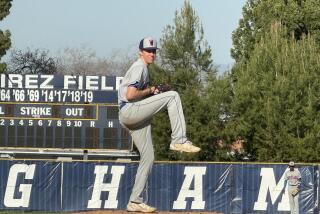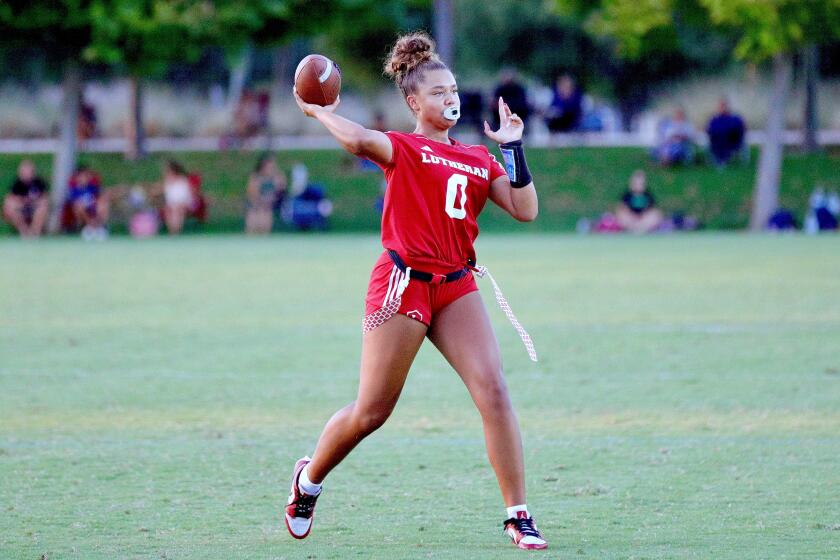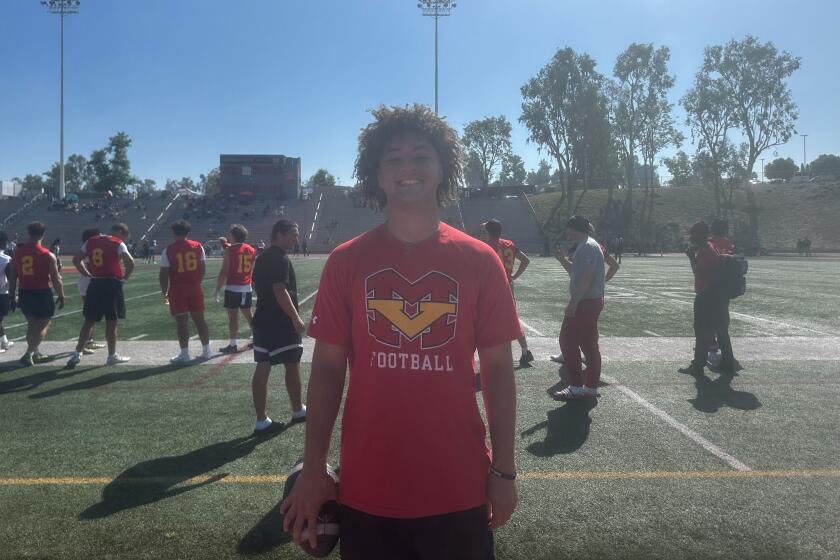HIGH LIFE : Puck, Pluck Needed to Play Hockey Out West
- Share via
On the West Coast, ice hockey gets about as much respect as zinc oxide does on the East Coast. But no one needs to tell that to members of the Tier II team which participates in the Southern California Amateur Hockey Assn. They learned it firsthand during a winter tournament in Minnesota.
“When they called our name,” team member Greg Hennig remembered, “they all went, ‘What? California? ‘ Then we beat the hell out of them.”
Tier II is out to ice over a few stereotypes.
In Minnesota, the team finished third among 20 teams. At a tournament last February in Colorado Springs, it beat squads from New York state and Vancouver, Canada, before falling in the finals to Team Colorado.
Six members of the West Covina-based Tier II team are from Orange County, where ice hockey doesn’t just take a back seat, it isn’t even in the car.
“There are millions of baseball fields and millions of soccer fields and just a couple of ice rinks,” said team member Chris Coniglio, a senior at Foothill High School in Santa Ana.
So, from September to April, the players travel twice a week to an ice rink in West Covina. They spend an average of $3,800 a year to play the sport. And they must contend with the Southern California stigma when they play outside the state.
“We don’t get as much recognition as people who grew up in a hockey atmosphere,” said team member Erven Vallero, a junior at Esperanza High School in Anaheim. “Sometimes, I think it’s really not fair. There are a lot of talented players in California who don’t get the recognition they should.”
Vallero, a native Californian, has never lived in the East but was on skates by age 4, playing hockey at ice rinks in Whittier and Brea. When those rinks closed, he moved on to West Covina, where he has built a solid reputation as a goal-scoring left-winger. But flipping pucks into the net like so many pancakes isn’t enough in hockey.
Vallero said survival depends on aggression.
“I do spend a little time in the penalty box,” he admitted. “I get my share (of penalties), maybe one or two a game.”
And Vallero isn’t about to let out-of-state competition dull his competitive edge. “We went out as a team and tried to show the rest of the country that California can play hockey. If we had everything that they have back East, we’d be just as good, even better. We can’t just walk down the street to a rink.”
Even so, the Californians proved in the finals in Colorado that they could skate with anybody. Charlie Coniglio, who coaches the Tier II team and the West Covina house team, the Southeastern Blues, certainly thinks so. “We got beat by Team Colorado, but they’ve been together five years and practice four days a week,” he said.
Compare that to the two hours each week the Tier II team spends on the ice. But with rinks closing faster than they’re being built--the West Covina rink is expected to close in a few months--even that meager ice time will be cut.
“If we could get someone to donate $25,000 to (support) each team, that’d be great,” the coach said. “(Tier II) is fortunate in that we’ve got Erven Vallero’s dad’s company (Tekform Products) sponsoring it.”
When Charlie Coniglio isn’t looking for corporate sponsors--as with ice rinks, there are never enough--he’s scouting players who know what it means to be a member of a team.
“You can’t have a team of prima donnas or goal-scorers,” he said. “There are two ends of the ice. It’s important that a team be made up of players who understand their roles. And, most of the time, these kids do.
“When I look for players to make up a team, I look for those qualities. I look for the skills, knowledge of the game, if they can think , if they keep their feet moving. . . . “
If anyone hustles, it’s Pete Scharnell, a junior at Newport Harbor High School in Newport Beach.
Scharnell was born in California but his family moved to Michigan, where he started playing hockey at 7 mainly because his older brother did. “We’d body-check each other around the house,” Scharnell said.
In 1980, his family returned to California--back to the same house--and he joined a state team that year, working to improve his speed all the while.
“I picked up skating pretty easily, so some of it is natural talent,” Scharnell said. “But I put in a lot of work. I do a lot of power skating--skating without the puck--and I work hard on the drills.”
Scharnell’s life runs along the same line as an old Sports Illustrated headline: “Speed Thrills.” That’s why hockey appeals to him, and why the fast pace extends beyond the rink to his school’s varsity soccer team and to snow skiing.
And he was fast enough to be recruited to play hockey for a Colorado prep school.
“But when I checked out the school, I decided my junior year was kind of late to be changing schools,” Scharnell said. “I’d be playing more hockey there, but I’d have to keep up with my studies, too.”
Scharnell may end up playing hockey in Colorado anyway. “I’d like to play for the University of Denver,” he said. “I’m pretty serious about hockey, but I’d like to be even more serious. I’d love to go to Colorado, and then I’d be even more serious.”
But even Southern California ice hockey can be a serious game with the season stretching from September to April. The players find it difficult to stray much beyond the ice during that time. Right-winger Chris Coniglio said: “You definitely have a better social life when the season ends. But then, there’s nothing to do after hockey.”
Coniglio’s relationship with hockey extends beyond the season because his coach is also his father.
“I don’t even think of him as my dad when he’s coaching,” Coniglio said. “People get mad at him and call him a jerk and I think, ‘Yeah, the coach is a jerk.’ People might think I’m spoiled or whatever, but I’m not.”
He certainly isn’t indulged when it comes to playing the boards. As his father and coach said, “Christopher is a mucker: a good, solid, checking forward.”
His body-checks are his trademark, though he is the shortest player in the lineup at 5 feet, 5 inches.
“Some people underestimate me,” Chris Coniglio said, “and then they find out. They take some cheap shots, but I give them cheap shots back, mostly in retaliation.”
This has been his style since he started skating at age 6 in New York. And he says if there’s one difference between East and West Coast hockey, it’s ignorance.
“When the people at school find out I play hockey, some of them act weird and ask dumb questions, like, ‘Have you had any teeth knocked out?’ ” For the record, Coniglio has a mouthful of teeth that could appear in any dental advertisement.
From March 28 through April 2, Coniglio and teammate Paul Voth, a junior at Los Alamitos High School, played--by invitation--with a Phoenix team that was participating in the Tier II-level nationals in Chicago. (The Tier II team’s name is the same as that of the national group.)
Their Tier II team had been upset in an earlier qualifying round by Team California. And although Coniglio found solace in his newly adopted Phoenix team beating Team California in Chicago, an injury dimmed his outlook.
In the second game of the tournament, the Phoenix team took the ice against a squad from Colorado Springs. In the second period, Coniglio was slammed off balance by one player and another checked him hard into the boards.
“It knocked me out a bit,” he said, “and when I came to, I knew what’d happened.”
He had separated his left shoulder and was on the bench for the rest of the tournament, which was crawling with National Hockey League and college scouts.
“But not many of the scouts came to where we were playing,” he said, “because we were from California and Phoenix.”
Voth, however, managed to survive the tournament and hopes to return in 1989.
“The scouts look at the seniors first, so maybe next year will be my year,” Voth said. And if this season is meant to serve as a foundation, then Voth’s is fairly solid. As Charlie Coniglio said, “He’s a defenseman’s defenseman. He controls the play in our end.”
And Voth can dominate. Off the ice, he starts for the Los Alamitos varsity football team at offensive guard, and in the spring he plays varsity baseball. Two hours of after-school sports practice followed by a couple of hours of homework and then another two hours of ice hockey doesn’t even faze him.
“Working out four hours isn’t really tiring,” Voth said. “But when I practice, I practice a lot and I practice hard. And then I lift weights at school and run sometimes.”
Of all the sports Voth plays, he prefers hockey. “It’s a fast-moving game,” he said, “and I’m pretty fast.”
Quick enough to hope he can skate into the NHL?
“I can only try,” he said. “There are a lot of other guys who want to be there too.”
One Tier II team member who did get his shot at playing professionally was Greg Hennig, a senior at Esperanza. In the spring of 1987, the left-winger was invited to try out with the Detroit Red Wings.
“When I got the letter, at first I was really confused,” he said. “I called them up and asked if they got the wrong guy.”
The Red Wing scouts had seen him play in a tournament. So last June, Hennig, the second youngest among 80 hopefuls, was in Detroit for the tryout.
“Just a little bit of pressure,” he said.
For those three days, Hennig, who was born in Michigan, scrimmaged constantly. Lacking the speed to keep up with the others, he made up for it with his play-making. As Tier II teammate John Hanson, a senior at Los Alamitos, said, “Sometimes he’ll come up with a move that I’ve never seen before.” But fancy moves weren’t enough for him to get invited to the second tryout.
Lack of speed, Hennig decided, was his deficiency. And despite interest from Iowa State, he doesn’t give himself much of a chance of playing college hockey.
“The people in college are just quick,” he said. “I’m not. When I worked at the Brea Mall ice rink, I used to practice skating there. But now that they’ve shut it down, there’s no place for me to skate.”
Hennig’s father had ensured his son’s participation in hockey by insisting, when his company transferred him to California in 1980, that the move be to a place near an ice rink.
But sometimes Hennig wonders what might have happened had he stayed in Michigan.
“I probably would have played for a high school team,” he said. “Their skills are a lot higher back East. Like when I was 13 or 14, I’d just tear right through everybody. But when I turned 15, I realized it wasn’t one-on-five anymore. Once you start realizing that, you say, ‘Wait a minute.’
“I probably won’t play after this season. That’s what my parents say. You can’t start to imagine how much it costs to play (in California). So high school, that’s just about where it ends.”
Hanson, who has played right-wing on Hennig’s line for the past four years, hopes not.
“There’s nothing like hockey,” said Hanson, who has played the game since age 5. “You can get hit and just get back up, and sometimes you can get hit by a guy and just get him back by a play or a goal. And then you’ve got a stick, and a lot of things can be done with that.”
After playing more than 170 games together, Hanson and Hennig pair up well.
“Me and Greg are sort of dedicated to hockey,” Hanson said. “We’re just like best friends. He’s a friend you don’t have to be around all the time to be friends with. We like the same things and we always room together if we can during tournaments.”
It was playing in tournaments that helped Hanson make up his mind about sports. Until last year, he divided his time between hockey and water polo. He finally chose to concentrate on hockey when he found he could compete--and compete well--against Eastern opponents.
“It’s great when you know you play better than some Eastern guy,” Hanson said. But to reach that level in the land of the sea and the sun takes some ingenuity.
One thing Hanson does in training is skate on roller blades, which are ice skates with wheels instead of blades. “It’s a great sensation,” he said. “I just go out there and tear up the pavement. But when you fall, it hurts; on the ice, it really doesn’t.”
He also used to play street hockey with Voth, who lives just a few houses away. Hanson has picked up enough moves to plan on playing hockey in college. He wants to play for the club team at Cal State Fullerton, where “I’ll get looked at a little bit and realize if I’m good enough to play college hockey in the East.”
“I think everybody who’s serious about the sport wants to play in college or the NHL, but I don’t want to build my hopes up,” Hanson said. “I just want to build my skills up to the college level. That’d really be fun, to go to college and play hockey. I just have a lot of fun in hockey. It’s an addiction.”
But it may be an endangered one. With the disappearance of ice rinks and lack of sponsors, along with the high cost of play, the existence of California teams like Tier II is being threatened. Still, Western players have Eastern dreams . . . with a laid-back twist.
“I’d love to play in the Olympics if I got good enough,” Vallero said, “and I’d love to play in college. But if I don’t make it, I’m not going to kill myself.”
More to Read
Get our high school sports newsletter
Prep Rally is devoted to the SoCal high school sports experience, bringing you scores, stories and a behind-the-scenes look at what makes prep sports so popular.
You may occasionally receive promotional content from the Los Angeles Times.






